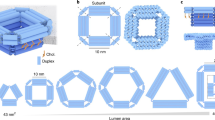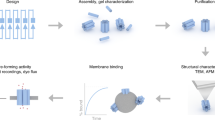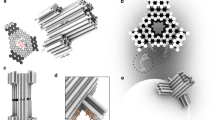Abstract
Synthetic nanopores have been used to study individual biomolecules in high throughput, but their performance as sensors does not match that of biological ion channels. Challenges include control of nanopore diameters and surface chemistry, modification of the translocation times of single-molecule analytes through nanopores, and prevention of non-specific interactions with pore walls. Here, inspired by the olfactory sensilla of insect antennae, we show that coating nanopores with a fluid lipid bilayer tailors their surface chemistry and allows fine-tuning and dynamic variation of pore diameters in subnanometre increments. Incorporation of mobile ligands in the lipid bilayer conferred specificity and slowed the translocation of targeted proteins sufficiently to time-resolve translocation events of individual proteins. Lipid coatings also prevented pores from clogging, eliminated non-specific binding and enabled the translocation of amyloid-beta (Aβ) oligomers and fibrils. Through combined analysis of their translocation time, volume, charge, shape and ligand affinity, different proteins were identified.
This is a preview of subscription content, access via your institution
Access options
Subscribe to this journal
Receive 12 print issues and online access
$259.00 per year
only $21.58 per issue
Buy this article
- Purchase on Springer Link
- Instant access to full article PDF
Prices may be subject to local taxes which are calculated during checkout






Similar content being viewed by others
References
Sexton, L. T. et al. Resistive-pulse studies of proteins and protein/antibody complexes using a conical nanotube sensor. J. Am. Chem. Soc. 129, 13144–13152 (2007).
Movileanu, L., Howorka, S., Braha, O. & Bayley, H. Detecting protein analytes that modulate transmembrane movement of a polymer chain within a single protein pore. Nature Biotechnol. 18, 1091–1095 (2000).
Howorka, S. & Siwy, Z. Nanopore analytics: sensing of single molecules. Chem. Soc. Rev. 38, 2360–2384 (2009).
Siwy, Z. et al. Protein biosensors based on biofunctionalized conical gold nanotubes. J. Am. Chem. Soc. 127, 5000–5001 (2005).
Ding, S., Gao, C. L. & Gu, L. Q. Capturing single molecules of immunoglobulin and ricin with an aptamer-encoded glass nanopore. Anal. Chem. 81, 6649–6655 (2009).
Uram, J. D., Ke, K., Hunt, A. J. & Mayer, M. Submicrometer pore-based characterization and quantification of antibody–virus interactions. Small 2, 967–972 (2006).
Branton, D. et al. The potential and challenges of nanopore sequencing. Nature Biotechnol. 26, 1146–1153 (2008).
Iqbal, S. M., Akin, D. & Bashir, R. Solid-state nanopore channels with DNA selectivity. Nature Nanotech. 2, 243–248 (2007).
Wanunu, M., Morrison, W., Rabin, Y., Grosberg, A. Y. & Meller, A. Electrostatic focusing of unlabelled DNA into nanoscale pores using a salt gradient. Nature Nanotech. 5, 160–165 (2010).
Uram, J. D., Ke, K., Hunt, A. J. & Mayer, M. Label-free affinity assays by rapid detection of immune complexes in submicrometer pores. Angew. Chem. Int. Ed. 45, 2281–2285 (2006).
Robertson, J. W. F. et al. Single-molecule mass spectrometry in solution using a solitary nanopore. Proc. Natl Acad. Sci. USA 104, 8207–8211 (2007).
Han, A. P. et al. Label-free detection of single protein molecules and protein-protein interactions using synthetic nanopores. Anal. Chem. 80, 4651–4658 (2008).
Ito, T., Sun, L. & Crooks, R. M. Simultaneous determination of the size and surface charge of individual nanoparticles using a carbon nanotube-based Coulter counter. Anal. Chem. 75, 2399–2406 (2003).
Talaga, D. S. & Li, J. L. Single-molecule protein unfolding in solid state nanopores. J. Am. Chem. Soc. 131, 9287–9297 (2009).
Oukhaled, G. et al. Unfolding of proteins and long transient conformations detected by single nanopore recording. Phys. Rev. Lett. 98, 158101 (2007).
Benner, S. et al. Sequence-specific detection of individual DNA polymerase complexes in real time using a nanopore. Nature Nanotech. 2, 718–724 (2007).
Clarke, J. et al. Continuous base identification for single-molecule nanopore DNA sequencing. Nature Nanotech. 4, 265–270 (2009).
Bayley, H. & Cremer, P. S. Stochastic sensors inspired by biology. Nature 413, 226–230 (2001).
Nakane, J. J., Akeson, M. & Marziali, A. Nanopore sensors for nucleic acid analysis. J. Phys. Condens. Matter 15, R1365–R1393 (2003).
Dekker, C. Solid-state nanopores. Nature Nanotech. 2, 209–215 (2007).
Martin, C. R. & Siwy, Z. S. Learning nature's way: biosensing with synthetic nanopores. Science 317, 331–332 (2007).
Movileanu, L. Interrogating single proteins through nanopores: challenges and opportunities. Trends Biotechnol. 27, 333–341 (2009).
Majd, S. et al. Applications of biological pores in nanomedicine, sensing, and nanoelectronics. Curr. Opin. Biotechnol. 21, 439–476 (2010).
Hou, X. et al. A biomimetic potassium responsive nanochannel: G-Quadruplex DNA conformational switching in a synthetic nanopore. J. Am. Chem. Soc. 131, 7800–7805 (2009).
Yameen, B. et al. Single conical nanopores displaying pH-tunable rectifying characteristics. Manipulating ionic transport with zwitterionic polymer brushes. J. Am. Chem. Soc. 131, 2070–2071 (2009).
Sexton, L. T. et al. An adsorption-based model for pulse duration in resistive-pulse protein sensing. J. Am. Chem. Soc. 132, 6755–6763 (2010).
Pedone, D., Firnkes, M. & Rant, U. Data analysis of translocation events in nanopore experiments. Anal. Chem. 81, 9689–9694 (2009).
Uram, J. D., Ke, K. & Mayer, M. Noise and bandwidth of current recordings from submicrometer pores and nanopores. ACS Nano 2, 857–872 (2008).
Fologea, D., Ledden, B., David, S. M. & Li, J. Electrical characterization of protein molecules by a solid-state nanopore. Appl. Phys. Lett. 91, 053901 (2007).
Chun, K. Y., Mafe, S., Ramirez, P. & Stroeve, P. Protein transport through gold-coated, charged nanopores: effects of applied voltage. Chem. Phys. Lett. 418, 561–564 (2006).
Hille, B. Ion Channels of Excitable Membranes (Sinauer Associaties, 2001).
Steinbrecht, R. A. Pore structures in insect olfactory sensilla: a review of data and concepts. Int. J. Insect Morphol. Embryol. 26, 229–245 (1997).
Zacharuk, R. Y. Antennae and sensilla, in Comparative Insect Physiology Chemistry and Pharmacology (eds Kerkut, G. A. & Gilbert, L. I.) (Pergamon Press, 1985).
Locke, M. Permeability of insect cuticle to water and lipids. Science 147, 295–298 (1965).
Nilsson, J., Lee, J. R. I., Ratto, T. V. & Letant, S. E. Localized functionalization of single nanopores. Adv. Mater. 18, 427–431 (2006).
Wang, G. L., Zhang, B., Wayment, J. R., Harris, J. M. & White, H. S. Electrostatic-gated transport in chemically modified glass nanopore electrodes. J. Am. Chem. Soc. 128, 7679–7686 (2006).
Wanunu, M. & Meller, A. Chemically modified solid-state nanopores. Nano Lett. 7, 1580–1585 (2007).
Watts, T. H., Brian, A. A., Kappler, J. W., Marrack, P. & McConnell, H. M. Antigen presentation by supported planar membranes containing affinity-purified I-Ad. Proc. Natl Acad. Sci. USA 81, 7564–7568 (1984).
Cremer, P. S. & Boxer, S. G. Formation and spreading of lipid bilayers on planar glass supports. J. Phys. Chem. B 103, 2554–2559 (1999).
Reimhult, E., Hook, F. & Kasemo, B. Intact vesicle adsorption and supported biomembrane formation from vesicles in solution: influence of surface chemistry, vesicle size, temperature, and osmotic pressure. Langmuir 19, 1681–1691 (2003).
Sackmann, E. Supported membranes: scientific and practical applications. Science 271, 43–48 (1996).
Miller, C. E., Majewski, J., Gog, T. & Kuhl, T. L. Characterization of biological thin films at the solid–liquid interface by X-ray reflectivity. Phys. Rev. Lett. 94, 238104 (2005).
Bayerl, T. M. & Bloom, M. Physical properties of single phospholipid bilayers adsorbed to micro glass beads—a new vesicular model system studied by 2H nuclear magnetic resonance. Biophys. J. 58, 357–362 (1990).
Caffrey, M. & Hogan, J. LIPIDAT: a database of lipid phase transition temperatures and enthalpy changes. DMPC data subset analysis. Chem. Phys. Lipids 61, 1–109 (1992).
Tokumasu, F., Jin, A. J. & Dvorak, J. A. Lipid membrane phase behaviour elucidated in real time by controlled environment atomic force microscopy. J. Electron Microsc. 51, 1–9 (2002).
Schuy, S. & Janshoff, A. Thermal expansion of microstructured DMPC bilayers quantified by temperature-controlled atomic force microscopy. ChemPhysChem 7, 1207–1210 (2006).
Gibbs, A. G. Lipid melting and cuticular permeability: new insights into an old problem. J. Insect Physiol. 48, 391–400 (2002).
Adam, G. & Delbrueck, M. Reduction of dimensionality in biological diffusion processes, in Structural Chemistry and Molecular Biology (eds Rich, A. & Davidson, N.) 198–215 (W. H. Freeman and Co., 1968).
Gambin, Y. et al. Lateral mobility of proteins in liquid membranes revisited. Proc. Natl Acad. Sci. USA 103, 2098–2102 (2006).
Grover, N. B., Naaman, J., Ben-sasson, S., Doljansk, F. & Nadav, E. Electrical sizing of particles in suspensions. 2. Experiments with rigid spheres. Biophys. J. 9, 1415–1425 (1969).
Grover, N. B., Naaman, J., Ben-sasson, S. & Doljansk, F. Electrical sizing of particles in suspensions. I.Theory. Biophys. J. 9, 1398–1414 (1969).
Neish, C. S., Martin, I. L., Henderson, R. M. & Edwardson, J. M. Direct visualization of ligand–protein interactions using atomic force microscopy. Br. J. Pharmacol. 135, 1943–1950 (2002).
Janeway, C. A. Immunobiology: The Immune System in Health and Disease 5th edn (Garland Publishing, 2001).
Schneider, S. W., Larmer, J., Henderson, R. M. & Oberleithner, H. Molecular weights of individual proteins correlate with molecular volumes measured by atomic force microscopy. Pflugers Arch. 435, 362–367 (1998).
Sivasankar, S., Subramaniam, S. & Leckband, D. Direct molecular level measurements of the electrostatic properties of a protein surface. Proc. Natl Acad. Sci. USA 95, 12961–12966 (1998).
Majd, S. & Mayer, M. Hydrogel stamping of arrays of supported lipid bilayers with various lipid compositions for the screening of drug–membrane and protein–membrane interactions. Angew. Chem. Int. Ed. 44, 6697–6700 (2005).
Capone, R. et al. Amyloid-beta-induced ion flux in artificial lipid bilayers and neuronal cells: resolving a controversy. Neurotox. Res. 16, 1–13 (2009).
Li, J. et al. Ion-beam sculpting at nanometre length scales. Nature 412, 166–169 (2001).
Lewis, B. A. & Engelman, D. M. Lipid bilayer thickness varies linearly with acyl chain-length in fluid phosphatidylcholine vesicles. J. Mol. Biol. 166, 211–217 (1983).
Acknowledgements
The authors thank D. Sept and D. Talaga for assistance in modelling distributions of translocation times and Y.N. Billeh for valuable discussions. The authors also thank D.J. Estes and J.D. Uram for their work on the LabView recording software. This work was supported by a National Science Foundation Career Award (M.M., grant no. 0449088), the National Institutes of Health (M.M., grant no. 1R01GM081705), the Alzheimer's Disease Research Center (J.Y., 3P50 AG005131), the Alzheimer's Association (J.Y., NIRG-08-91651), the National Human Genome Research Institute (J.L., grant nos HG003290 and HG004776) and a Graduate Assistance in Areas of National Need Fellowship (E.C.Y).
Author information
Authors and Affiliations
Contributions
E.C.Y., J.Y., and M.M. conceived and designed the experiments. E.C.Y., J.M.J., S.M. and P.P. performed the experiments. R.C.R. and J.L. fabricated the nanopores. E.C.Y., J.L., J.Y. and M.M. co-wrote the manuscript and Supplementary Information.
Corresponding authors
Ethics declarations
Competing interests
The authors declare no competing financial interests.
Supplementary information
Supplementary information
Supplementary information (PDF 2642 kb)
Rights and permissions
About this article
Cite this article
Yusko, E., Johnson, J., Majd, S. et al. Controlling protein translocation through nanopores with bio-inspired fluid walls. Nature Nanotech 6, 253–260 (2011). https://doi.org/10.1038/nnano.2011.12
Received:
Accepted:
Published:
Issue Date:
DOI: https://doi.org/10.1038/nnano.2011.12
This article is cited by
-
High-resolution discrimination of homologous and isomeric proteinogenic amino acids in nanopore sensors with ultrashort single-walled carbon nanotubes
Nature Communications (2023)
-
Polymer Translocation
Chinese Journal of Polymer Science (2023)
-
Comprehensive structural assignment of glycosaminoglycan oligo- and polysaccharides by protein nanopore
Nature Communications (2022)
-
Integrated microdevice with a windmill-like hole array for the clog-free, efficient, and self-mixing enrichment of circulating tumor cells
Microsystems & Nanoengineering (2022)
-
Focus on using nanopore technology for societal health, environmental, and energy challenges
Nano Research (2022)



